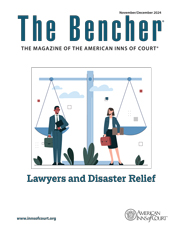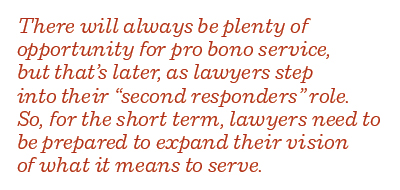Lessons from the Nashville Flood
The Bencher—November/December 2024
By Candi Henry, Esquire
 On May 1, 2010, an ecological disaster was unfolding off the Gulf Coast. Weather patterns indicated that the massive oil leak caused by the Deepwater Horizon explosion several days before would inevitably reach U.S. soil, stretching from Louisiana to Florida, devastating sea life and threatening up to 40% of the country’s marshland.
On May 1, 2010, an ecological disaster was unfolding off the Gulf Coast. Weather patterns indicated that the massive oil leak caused by the Deepwater Horizon explosion several days before would inevitably reach U.S. soil, stretching from Louisiana to Florida, devastating sea life and threatening up to 40% of the country’s marshland.
While the nation turned its attention to the catastrophe in the Gulf, it’s safe to say that many people in Nashville, Tennessee, didn’t notice. That’s because on May 1, 2010, it had started raining, and by May 2, it hadn’t stopped. In two days, 13.75 inches of rain immobilized the region, with the rain falling more than one inch per hour for hours at a stretch. It was an experience that still defies explanation.
The Cumberland River that divides the downtown from East Nashville crested almost 12 feet above flood stage. The Harpeth River also flooded, along with the network of creeks that weave their way throughout the area. On the Duck River, flood waters rose so much as to wash away the gauge that would have indicated how high it crested.
More than 10,000 homes were damaged or destroyed. Businesses were paralyzed, including the Grand Ole Opry, the Opryland hotel (which had to evacuate 1,500 people), and the Schermerhorn Symphony Center, which was invaded by 24 feet of water. Water treatment facilities were overrun, resulting in shortages; roads closed because bridges simply vanished. Twenty-six people in the region died.
The devastation was immense, and Middle Tennessee was left largely to fend for itself. In fact, a 2020 retrospective article in The New York Times was titled “Nobody Cared When Nashville Drowned.” Multiple reasons may explain the relative lack of national attention to Nashville’s $2 billion natural disaster, but the one I like to focus on is what has been described as a “remarkably organized and smooth” recovery process. Indeed, one might say that the Nashville Flood provides a textbook example of local community disaster response. At the very least, it certainly offers some insightful takeaways for lawyers.
Help the First Responders, Then Be the Second Responders
When disaster strikes, first responders need to be able to do their jobs. This means that lawyers should be prepared to do the things that need to be done in service of first responders. Police forces, fire departments, health care workers, and transit providers must mobilize their resources. Sometimes this means having to move equipment or borrow supplies or staffing from another agency. When that happens, no one has time to go five rounds with legal over an indemnity clause.
In 2010, I was in private practice at a firm in Nashville that served as outside general counsel to the Metro Transit Authority (MTA). When MTA’s bus storage facility started to flood and vehicles needed to be relocated, the metro government offered space. Sure, it was important to get a memorandum of understanding (MOU) in place, but neither client’s needs would have been served had the lawyers insisted upon customary formalities such as exchange of legal blacklines or receipt of “wet” signature execution of documents.
Our clients granted us a wide swath of authority, and the exigency drove the lawyering. All around the city, similar agreements—written and unwritten—had to be put in place quickly, with a minimum of deliberation and an ample dosage of faith in the legal profession.
 What we also found was that, in the early days after the flood, traditional walk-in legal clinics were not of much use. When people are focused on survival and assessment, they are not framing matters as legal issues. There will always be plenty of opportunity for pro bono service, but that’s later, as lawyers step into their “second responders” role. So, for the short term, lawyers need to be prepared to expand their vision of what it means to serve.
What we also found was that, in the early days after the flood, traditional walk-in legal clinics were not of much use. When people are focused on survival and assessment, they are not framing matters as legal issues. There will always be plenty of opportunity for pro bono service, but that’s later, as lawyers step into their “second responders” role. So, for the short term, lawyers need to be prepared to expand their vision of what it means to serve.
Expand Your Definition of Legal Services
In an emergency, immediate, reliable information is key. What do you do if your medication has been destroyed? What if you receive food stamps and you lost your food in the flood? As cleanup and recovery commences, other questions arise: What do you do if savings bonds or securities have been destroyed? How do you dispose of debris? What if you can’t afford a permit to begin repairs? Laws and regulations govern all these situations. So, while these circumstances do not necessarily call for lawyers to provide active representation, lawyers have a role to play by collecting and distributing information.
Most law firms have robust networks, and many are positioned to send newsletter blasts or post and publicize blogs. While they can disseminate verified information about “legal matters,” lawyers can also lend their credibility to providing other helpful and authoritative information. Sharing a few bullet points on how to avoid disaster assistance scams can prevent legal problems. When community businesses step in to offer assistance, lawyers can help spread the word. After the flood, lawyers helped publicize the availability of free storage units, restoration of damaged photographs, and durable medical equipment.
As always, familiarity with relevant technologies can be a crucial part of providing legal services. Today, websites are built on user-friendly designs with interfaces that allow one to make changes, upload files, and even change entire design themes without having to know any code. But in 2010, many websites were still custom-coded and required a webmaster or other professional to make changes. That was still the case for many government agencies and nonprofits in the metro area. Those organizations were busy on the ground and simply weren’t in a position to make frequent changes to their websites to share information about the disaster response. My firm used the freely available Blogger platform to start a website that collected and shared information from the government entities, nonprofits, and other sources of help and that could be updated almost instantaneously.
Lawyers in Nashville were able to become sources of trusted information because their networks were integrated with the fabric of the community, whether as volunteers or directors of nonprofits, members of faith communities, or as Little League parents. But they also knew each other and were accustomed to working together. This leads to perhaps the most useful tip for lawyers looking for advice on how to prepare for emergencies: every day, your personal and professional interactions can prepare you to help your community.
Build Your Network Before You Need It
Nashville’s lawyers have always had a reputation for congeniality. Even as the city started its seemingly never-ending growth spurt in the mid-aughts and lawyers were increasingly arriving from out of state, the bar remained welcoming. It’s easy to be genial when you know someone, and one of the best ways for lawyers to get to know each other is to become involved in bar and other professional associations.
In Nashville, the Harry Phillips American Inn of Court has been connecting lawyers since 1990, and the flood saw many then-current and former Inn members (including members of my firm) have the opportunity to work together to connect clients and causes. Relationships are built on shared experiences, and lawyers should take every opportunity to foster fellowship among the bar. This leads to the needed trust in opposing counsel when getting an emergency MOU in place or the ability to phone a friend to ask, “How do you appeal a denial of emergency unemployment benefits?” It also leads to simply knowing the right person at the right time—whether that’s the corporate general counsel, the director of the board, or the mayor, whose ear you need and whom you know because you were in the Inn together.
Parting Thoughts
Nashvillians are proud of their legacy in responding to the flood. More than 29,000 volunteers would go on to work for months in various recovery efforts. Country music legend Garth Brooks was compelled to perform in Nashville for the first time in more than a decade, selling 140,000 tickets at a discounted rate of $25 and raising $3.5 million to benefit the Community Foundation of Middle Tennessee. The spirit of the region emerged like the proverbial rainbow after the storm.
Nashville’s remarkable recovery can be attributed to multiple sources. Certainly, lawyers were only a part of that effort. But the lessons from the flood make Nashville lawyers proud of our community and profession. Those lessons served as guideposts for response in March 2020 when Nashville experienced the one-two punch of a devastating tornado followed by the COVID-19 pandemic, and they will continue to help form a foundation to face whatever may be next.
Candi Henry, Esquire, is chief legal counsel for the Greater Nashville Regional Council, a council of governments comprising 13 counties in the Middle Tennessee area. She is a member of the Harry Phillips American Inn of Court.